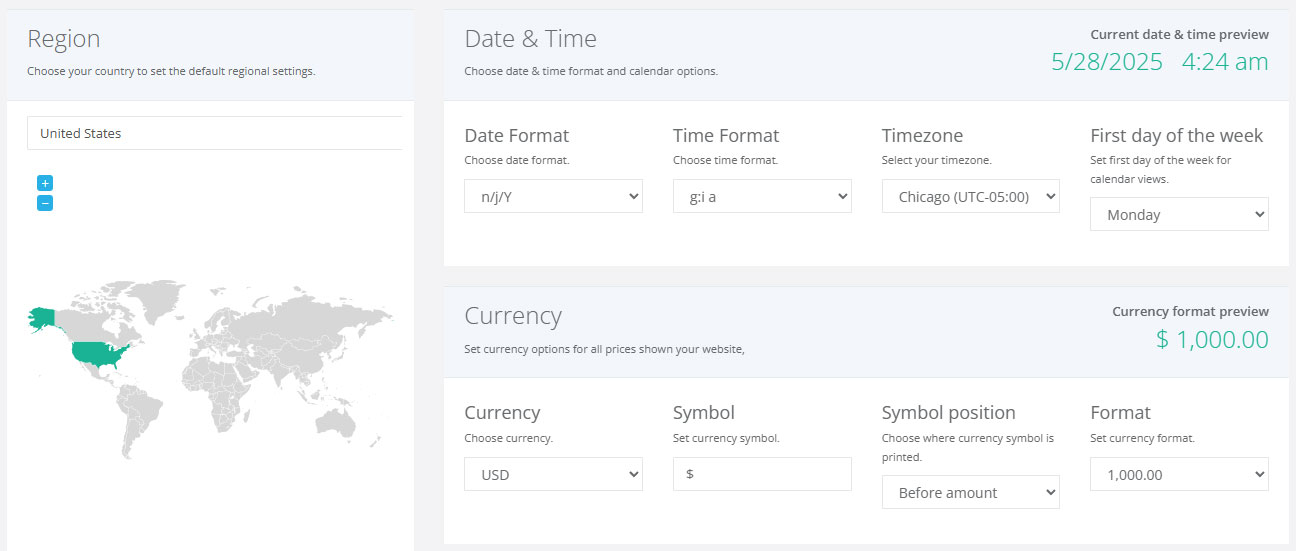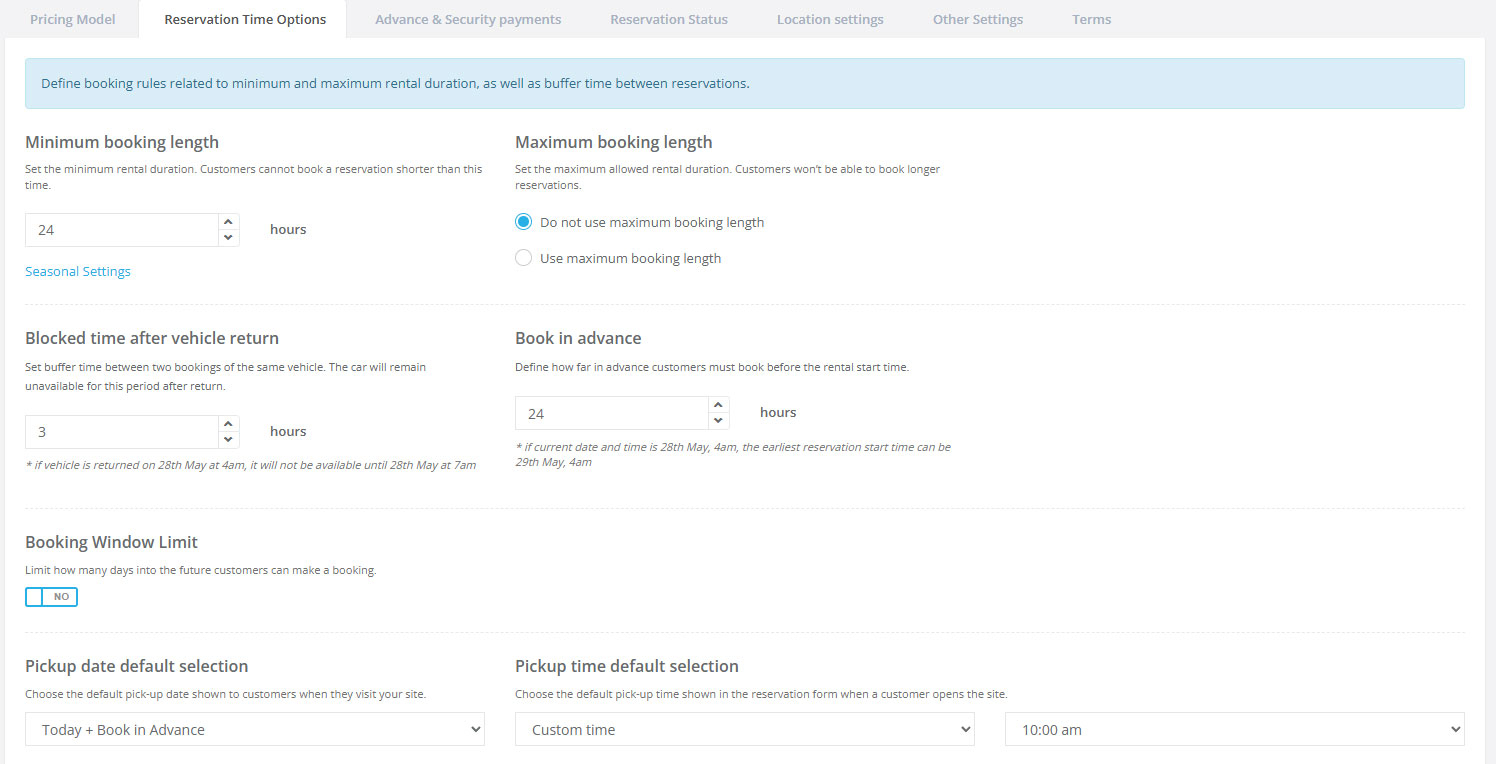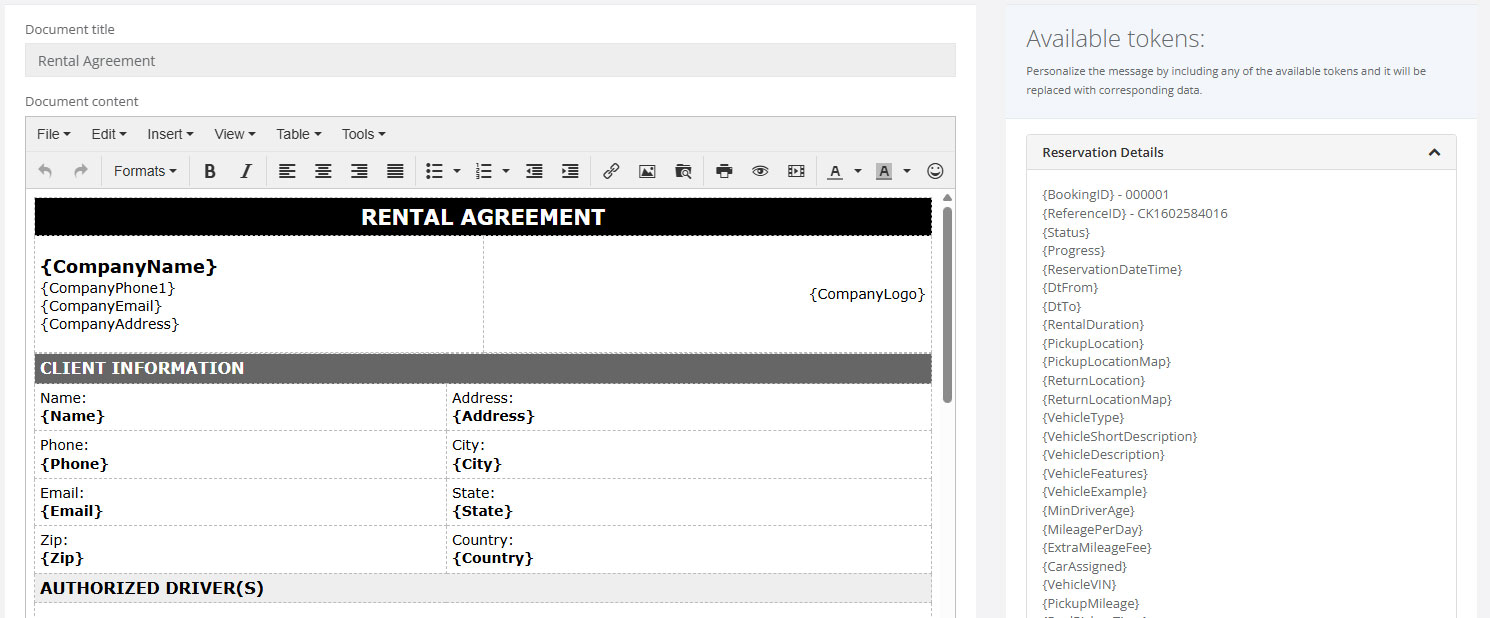If you have any questions or dificulities manging your business website, just reach out to our Customer Success Managers!
Welcome to your First‑Day Configuration Guide for VEVS Car Rental Software—a practical roadmap that turns a freshly installed system into a revenue‑ready booking engine. Instead of walking you through every click, this tutorial explains why each setting exists and what business problem it solves, so you can make confident, informed choices from the outset. Work through the sections in order, and you’ll finish with regional formats that match your locale, rental rules that reflect your operating policy, a fleet your customers can actually book, and the payments, taxes, and documents that keep everything compliant. In short: follow this checklist today and you can accept your first online reservation tomorrow—stress‑free.
Pick the time zone where your vehicles actually operate (e.g., “Europe/Sofia” rather than the headquarters’ or server’s zone). This ensures that every timestamp—availability searches, pick‑up/return deadlines, automated emails, and payment‑gateway logs—reflects local clock time. A correct time‑zone setting prevents overnight bookings from spilling into the wrong calendar day, keeps scheduled notifications (like reminder emails) from firing at odd hours, and guarantees that office staff and customers are always “speaking the same clock language.”
Before you add a single car or price, tell the system what “$”, “€”, or “05/09/2025” actually mean to you. Selecting the correct currency guarantees that every fee you enter later—rental rates, deposits, extras—will be stored and displayed in the same monetary unit. This prevents rounding errors during online payment and keeps your accounting tidy.
Just as important, the date & time format (“DD/MM/YYYY 24 h” vs. “MM/DD/YYYY 12 h”) removes any ambiguity from pick‑up and return times; mis‑interpretation here is one of the most common causes of charge‑backs and disgruntled reviews. Saving these two values first lays a rock‑solid foundation for every other price or time rule you create.

Rental Settings is the command‑centre where your real‑world policies become automated software rules. Every toggle you set here—whether it’s pricing logic, driver eligibility, or mileage caps—instantly shapes the behaviour of the booking engine, the totals customers see, and the protections built into every contract. Configure these rules once, and VEVS will enforce them around the clock, turning your operating handbook into self‑running code. Below are just a few of the rule categories you can enable—each with a brief explainer to show why it matters:
- Pricing Model – Decide whether the system charges per day, per hour, or a blend of both. This single switch shapes how every reservation total is calculated.
- Minimum / Maximum Booking Length – Stop loss‑making one‑hour bookings or ultra‑long reservations that hog vehicles during peak season.
- Blocked‑Time Buffer – Reserve cleaning or inspection time after each return so the same car isn’t re‑booked while it’s still in the wash bay.
- Advance Payment & Security Deposit – Collect a percentage or fixed amount up front to reduce no‑shows and cover damage risk.
- Different Return Location & Relocation Fee – Allow profitable one‑way rentals while automatically recovering the cost of bringing the car home.
- Mileage Limit & Distance Packages – Offer unlimited mileage for tourism markets or sell prepaid kilometre bundles for long‑distance travellers.
- Driver Age Range & Young‑Driver Fee – Keep your insurance valid by blocking underage drivers, or monetise the extra risk with a surcharge.
- Custom Terms & Conditions – Embed your cancellation policy, fuel rules, and liability clauses so every customer ticks “I agree” before paying.

Each branch, airport desk, or delivery service becomes a selectable option during Step 1 of the booking funnel. When you create a rental location, go beyond the street address and map pin:
- Working hours – Enter the daily opening and closing times so the booking engine refuses pick‑ups or returns outside staff availability, eliminating after‑hours surprises and penalty waivers.
- Premium‑location fee – Flag airports, train stations, or downtown hotspots with a surcharge that is automatically added to every booking starting or ending there, letting you recover higher concession rents and parking costs without manual edits.
- Pick‑up / Return permissions – Specify whether the branch handles pick‑ups only, returns only, or both. This instantly controls the one‑way routes offered online, steering customers toward operationally feasible combinations and preventing “orphan” cars.

Customers shop by type (“Medium SUV Automatic”) rather than by licence‑plate. Setting clear categories with thumbnails and daily prices lets them filter quickly, reducing abandonment. Yet a type without at least one active vehicle remains invisible on the website. Adding your physical cars—complete with licence plate, fuel kind, odometer—links real‑world availability to the virtual shelf. Planned maintenance dates entered here will later block the car automatically, preventing accidental double‑booking.

Extras do more than pad your bottom line; they solve customer problems and improve satisfaction. A well‑timed GPS rental can be the difference between a 5‑star review and an angry “got lost” call. Distance Packages let you monetise high‑mileage travel without punishing short‑distance renters. Protection Plans give risk‑averse drivers peace of mind and you an ancillary revenue stream. Set them all up now so customers see a complete, professional offering from day one.
Whether it’s VAT, GST, or a city‑imposed fleet levy, taxes must appear correctly on every quote and invoice. Define the rate and decide whether it is included in the advertised price (common in Europe) or added at checkout (standard in North America). Get this wrong and you’ll spend hours issuing corrected invoices—or worse, face penalties.
An enabled payment gateway turns browsing traffic into confirmed revenue while you sleep. Integrating Stripe or PayPal means cards are tokenised and deposits collected instantly, slashing no‑show rates. If you rely on “Pay on arrival”, activate at least one offline option (cash/POS) so the booking engine still records a payment method. Whatever you choose, align the gateway’s supported currencies with the one you set in Step 1 to keep statements reconcilable.

This is the final quality‑check that turns a functional system into a professional customer experience. Here you personalise the rental agreement with your own legal wording, update notification emails so every message sounds like your brand, and trim the checkout form to collect only the details you really need. These quick refinements eliminate last‑minute surprises, reinforce trust, and ensure every touch‑point—from booking to pickup—feels seamless and consistent.
- Rental Agreement Template – Replace the stock Rental Agreement with your own terms—covering liability, fuel, mileage, and local legal clauses—so every booking reflects your real policies. Decide whether to enable the built‑in digital signature for a fully paperless, time‑stamped contract or keep signatures on paper at pick‑up. Finally, choose whether the agreement should attach automatically to the “Booking Confirmed” email so customers receive the rules in writing the moment they reserve.
- Notification Messages – Default emails are functional but impersonal. A quick rewrite can add local travel tips, branch contact numbers, or upsell links, turning routine notifications into brand‑building touchpoints.
- Checkout Form – Collect only what you genuinely need (e.g., flight number for airport pick‑ups). Each unnecessary field is an extra hurdle on mobile. Fine‑tuning the form boosts conversion and protects customer privacy.

By taking the time to understand why each setting exists—and shaping it to match your operational reality—you transform VEVS from a generic booking system into a seamless extension of your rental business. Once these eight areas are complete, make a test reservation as a customer: every element you configured will surface in the journey you just built. If that experience feels clear, fair, and professional, you’re ready to open the digital doors and start accepting real‑world bookings with confidence. Happy renting!
